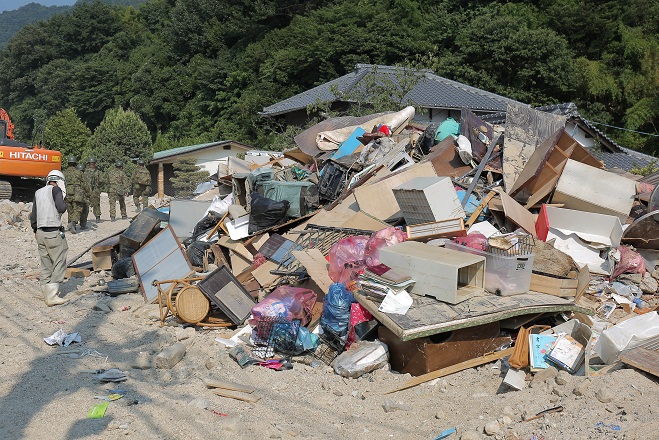3,600 People Still at Shelters One Month after Rain Disaster
August 6, 2018
Okayama/Hiroshima- Some 3,600 people were still at shelters and about 24,000 people remained under evacuation orders on Monday, one month after the first special warnings on torrential rain were issued before a disaster mainly in western Japan.
The death toll from floods and landslides caused by the rain has reached 219 in 14 of the country's 47 prefectures, with 11 people unaccounted for in three prefectures.
Police officers, firefighters and Self-Defense Forces troops are continuing their search operations.
In locations in disaster-hit areas, people offered prayers for those who lost their lives one month ago.
At one shelter in the Mabi district in Kurashiki, Okayama Prefecture, some 30 residents and staff members joined hands to mourn the victims. A total of 51 people died in Mabi.
During a one-minute silent prayer at the shelter, Yutaka Sumasu, 85, a resident of Mabi, remembered his late relative, Seishiro Sumasu, 92, who was union head at a local agricultural cooperative.
"He was stubborn but trusted by everyone," said Sumasu, whose house was destroyed in the disaster.
The Japanese government has decided to spend 105.8 billion yen from reserve funds to finance reconstruction in rain-hit areas, hoping to help affected people rebuild their lives in cooperation with local governments and private entities.
"The central government will work together with affected local governments to help achieve reconstruction," Chief Cabinet Secretary Yoshihide Suga told a press conference in Tokyo on Monday. "We'll implement the necessary measures with a sense of speed."
Up to 260,000 households had no running water in the rain-hit region, but the number had fallen to 8,074 as of Thursday, according to the health ministry.
But water supplies remain disrupted at five medical institutions in Uwajima, Ehime Prefecture, where a water treatment plant was damaged by a landslide.
According to the transport ministry, all closed expressway sections have reopened to traffic except two, including one in Hiroshima Prefecture that was hit by the collapse of a nearby slope.
Affected railroad lines have started to reopen one after another. The Tsuyama Line of West Japan Railway Co. <9021>, or JR West, in Okayama fully resumed operations on Sunday.
By Friday, over 130,000 volunteers had taken part in activities to help affected residents, according to a survey by the Japan National Council of Social Welfare.
A report compiled by Motoyuki Ushiyama, professor at Shizuoka University's Center for Integrated Research and Education of Natural Hazards, shows that more than half of the people who died or went missing in the disaster became victims while indoors.
This is contrary to the trend in past floods for more people to die outdoors, according to Ushiyama. Jiji Press
Latest Videos
- THE UNTOLD STORY EXPERT INSIGHTS INTO THE UKRAINE
- NEGOTIATING A NEW ORDER US RUSSIA TALKS ON UKRAIN
- Ukraine: A Pawn in the Geopolitical Game? Will Trump Intervene?
- US VP VANCE CRITICIZES EUROPEAN DEMOCRACIES AT MUNICH SECURITY CONFERENCE
- UNCOVERING THE WEB OF DECEIT: CIA INFILTRATION OF THE MEDIA
- SHIFTING SANDS: TULSI GABBARD’S CONFIRMATION AND THE EVOLVING GLOBAL LANDSCAPE
- FAUCI SCANDAL: A THREAT TO GLOBAL HEALTH AND DEMOCRACY






